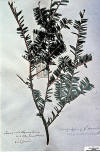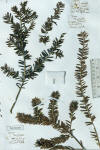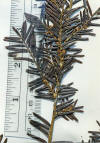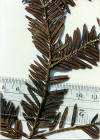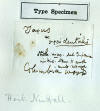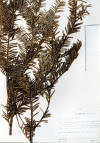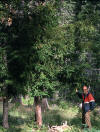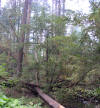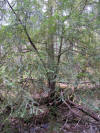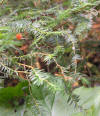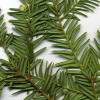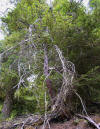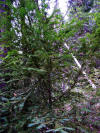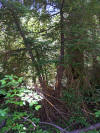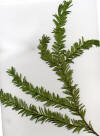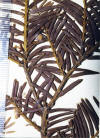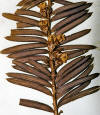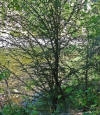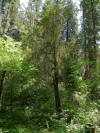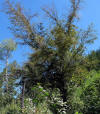3. Taxus brevifolia Nuttall, N. Amer.
Sylv. 3: 86 (1849).
Tab. 108 captioned “Taxus Taxus boursieri Carrière, Rev. Hort. 1854: 228 (1854), no specimens cited. Type: U.S.A., California, “forests near stream with Thuja, Abies grandis, Pinus lambertiana,” described as an arborescent shrub with slender branches, leaves 1.5–1.8 cm long, glaucous below, original material unknown. Neotype (designated by Spjut 2007b)—California, Siskiyou Co., Shasta Springs, Jepson s.n., Aug. 1894 (US!). Taxus lindleyana M. A. Murray, Edinburgh New Philos. J. 1:294. 1855. Also, Rev. Hort. sér 4, 4:379. 1855; Lawson ex Carrière, Traité gén. conif. 523 (1855). Type: U.S.A., California, north and east of San Francisco between 40° and 41° latitude [Klamath Region], “along sides of a glen. under the shade of larger trees”; lectotype (designated by Spjut 2007b) from original material of two specimens at Edinburgh—specimen with accession number E00030316 (E!), shown below, annotation Taxus lindleyana, presumably by Murray, additional notation indicating journal publication (possibly R. Jameson), and another notation indicating “probably only a form of T. baccata, perhaps the T. cuspidatus [spelling?] of Sieb. & Zucc.” Another specimen annotated T. lindleyana was indicated to have been collected from Vancouver, which may have been before his trip to California.
Distribution: S coastal Alaska to central California—Coast Ranges at least to San Mateo Co. [based on one or two specimens, one collected by Bolander (US) that is questionable and another collected by Stokes (US)], and quite likely further S to Santa Cruz Co., Laguna Creek, and along the W Sierra Nevada at least to Calaveras Co., Big Trees State Park, possibly further south to Yosemite Natl. Park (Lemmon, yr 1874), or to Tulare Co.; generally southern Canadian Rockies from British Columbia and western Alberta to western Montana; often in shade of old-growth forests on northern slopes, in bottomland forests, occurring also in seral communities along streams and forest margins; often in mixed evergreen and montane coniferous forests from sea level to 2650 m; most frequent in forests dominated by western hemlock along W Cascades (Franklin & Dyrness 1969), Douglas fir (Eliot 1938] and lowland fir (Bolsinger & Jaramillo 1990), or sitka spruce and western red cedar in the northern range (Taylor 1932; Taylor & Taylor 1980); occurring with Douglas fir in 89% of the stands in western Oregon (Bolsinger & Jarmillo 1990) a relationship which may be mutualism or commensalism appears evident by the yew often occurring near the base of the Douglas fir. Comments on the southern limits of the geographical distribution (Oct 2007, Jan 2009): Spjut (1977, 2007) indicated that the southern distributional limits of the species as possibly in Marin County along the Coast and Tulare County in the Sierra Nevada; however, these reports have been questioned. The Marin Flora by Howell, Almeda, Follette and Best (Calif. Acad. Sci. and CNPS, 2007) mentioned a discovery of T. brevifolia by Robert H. Menzies in 1932 as being found between Olema and Bear Valley that has since been searched for but not found. The authors further indicate that Marin County is the southern distribution limits for T. brevifolia along the Pacific coast; however, the southern coastal limits of the species extends to at least San Mateo County based on two herbarium specimens cited by Spjut (2007a), a US specimen collected by Stokes from San Mateo County, which belongs to var. brevifolia, and another US specimen collected by Bolander (Bolander 186) from “Forest Hills, Devil's Canyon.” The locality from which Bolander 186 was obtained is not entirely clear. “Forest Hills,” “Devil's Canyon,” (Bolander 186, US) has been reported for a location in the Sierra Nevada (M. A. Howe in The Hepaticae and Anthocerotes of California (1899, Mem. Bot. Torrey Club Calif. VII) based on Bolander 4620 for “Kantia trichomanis” [=Calypogeia fissa (L) Raddi]; however, all other collections cited by Howe (1899) for this taxon are from the California coast, obtained by other collectors. Additionally, there is a higher numbered specimen by Bolander of T. brevifolia (Bolander 4554, UC, US) from “near Forest Hills” in Placer County (Consortium of California Herbaria) but without mention of Devil's Canyon (except by Parlatore 1868 without reference to collection number); associated with this number are a series of collections from “Forest Hill” or “Forest Hills (Consortium of California Herbaria),” e.g., Bolander 4551 (Nemophila maculata, “Auburn to Forest Hill at Grizzly Bear House”), Bolander 4552 (Tropidocarpon gracile, “on stage road from Aubern to Forest Hills”), Bolander 4553 (Isopyrum occidentale, “near Forest Hill”), Bolander 4557 (Ceanothus prostratus, “Forest Hill”), Bolander 4558 (Ceanothus tomentosus, “Forest Hills”), and more isolated numbers, 4575, 4576, 4617 and 4629. The Google Earth shows a Devil's Canyon near Foresthill in Placer County. [A Devil's Canyon also lies further south in the Sierra Nevada off the South Fork Kaweah River just outside the Sequoia National Park in Tulare County, but the vegetation at this site as seen from Google Earth does not appear favorable for T. brevifolia]. There is also a Bolander 186 listed in the Consortium of California Herbaria for Arnica mollis, with locality unknown. This species is found in the Cascades and Sierra Nevada, including counties of Placer, Mariposa, and Tulare. This is in contrast to other collections by Bolander reported from the coast, close to his number 186. One is Bolander 69 for Carex comosa from the Santa Cruz Mountains (Mackenzie, Monograph of the California species of the genus Carex, 1922, Erythea Vol. 8, edited by Jepson), which a Bolander specimen without number and location is listed in the Consortium of California Herbaria among only 16 records for this species, three of which are from the coast, Santa Cruz Co., San Francisco and Sonoma Co. near Guerneville. Another is Bolander 150 from San Bruno Mountain (which is in San Mateo County) for the lichen Buellia pustullata (Herre, The lichen flora of the Santa Cruz Mountains, Proc. Wash. Acad. Sci. 12(2): 27–269, 1910). A gazetteer by David L. Durham (California's Geographic Names: A Gazetteer of Historic and Modern Names of the State, 1998, Quill Drivers Books) indicates a Devil's Canyon extends from San Mateo County to Santa Cruz County [“Peters Creek, stream flows 7 miles to Pescadero Creek 4 miles south of Mindego Hill, lat. 37º15'06"N, long. 122º15 W; sec. 8, T8S R3W, the stream drains Devil's Canyon. Brown (p. 27), used the name Devil's Canyon Creek for the stream in Devil's Canyon, and noted (p. 68) that the name 'Peters' is for Jean Peter who settled near the creek in 1860”] and that Devil's Canyon itself is in reference to the upper reaches of Peter's Creek in San Mateo County. A Forest Hill community—that was developed in 1912—is located in Burlingame, San Mateo Co. It might be noted that in Bolander's Catalogue of the plants growing in the vicinity of San Francisco (1870, A. Roman & Co. Publishers), only Torreya is listed, not Taxus, and that he had also collected in Sonoma County where there is a Forest Hills settlement 4 miles east of Guerneville along the Russian River, while the Consortium of California Herbaria shows only one collection of Torreya by Bolander that he reportedly obtained from Big Trees in Mariposa County. Here it might be noted that Bolander rarely collected specimens of trees and shrubs; for example, there are no species of manzanita, Douglas fir, or spruce among more than 1200 records of vascular plants in the Consortium of California Herbaria; occasionally he collected a willow or oak or pine. Notable exceptions include Myrica hartwegii from Big Tree Grove in Mariposa County (Bolander 5002) and Staphylea bolanderi (Shasta Co. McCloud River, Bolander, Kellogg et al. s.n., Apr 1874, type GH) . Most of his collections appear to be herbaceous species, lichens and bryophytes. The reported occurrences in the Santa Cruz Mountains are based on John G. Lemmon's Handbook of West-American Cone bearers (1895) which may be traced to C. L. Anderson (1891; Catalogue of flowering plants and ferns of Santa Cruz County, California; in E. S. Harrison, History of Santa Cruz County, California, Pacific Press Publ., San Francisco, Chapter IX). Anderson (1891) made specific reference to Laguna Creek for T. brevifolia, suggesting a rather localized occurrence in Santa Cruz County, compared to other comments he made about the occurrences of plants in his checklist. This location with reference to C. L. Anderson was also mentioned by Jepson and Dempster in A flora of California (1909, Cunningham, Curtiss & Welsh). Modern checklists of the area (e.g., R. Morgan et al. 2005. An annotated checklist of the vascular plants of Santa Cruz County, California. California Native Plant Society; SEINet 2006 (previously available online), did not include T. brevifolia, however. Dr. Anderson, a physician, frequently sent his specimens to Asa Gray for identifications, but there are no specimens of T. brevifolia from the Santa Cruz Mountains in Harvard and other California herbaria (Thomas, Flora of the Santa Cruz Mountains of California, 1991, Stanford Univ. Press), while it must be noted that Anderson's (1891) checklist was derived largely from another by F. L. Clarke (1890, Catalogue of flowering plants and ferns of Santa Cruz County, California, Pamph., 13 pp.; see Bull. Torrey Bot. Club, 1892) based on specimens collected by students as a result of a county-wide “wildflower contest” among the public schools. [Updated 22 Dec 2009]. The southern distribution limits of Taxus brevifolia in the Sierra Nevada has been questioned (P. W. Rundel, The southern limits of Taxus brevifolia in the Sierra Nevada, Madroño 19: 300, 1968; Spjut 1977). It has been reported as Tulare County (Jepson, Silva of California, 1910; Univ. Press, pp. 164-168; Sargent, Silva of North America 1896) with further reference to Sequoia National Park (Spjut 2007b); however, present day records of the species are not known south of Calaveras County (the North Grove, Calaveras Big Trees State Park. Dean Wm. Taylor, pers. comm., Sep 2007 (see also http://californiabotany.blogspot.com/2009_04_01_archive.html); Rundel 1968). Other reported occurrences south of Calaveras County are based on specimens from Mariposa County collected by J. W. Congdon (15 Aug 1901, E00094392, E00094387) and by Lemmon (John Muir) from Yosemite Natl. Park (UC334344; US; collected Sep 1874) and literature with references to Merced Canyon (K. Brandegee, The Flora of Yo Semite, Zoe 2: 155–167 , 1891; also in Harvey and Carlotta Hall, A Yosemite Flora, 1912). It is interesting to note that Lemmon (1895) reported only Torreya in Yosemite, while there are no Lemmon specimens of this species from Yosemite in the Consortium of California Herbaria, only Taxus. Additionally, a Natureserve report (Classification of the Vegetation of Yosemite National Park and Surrounding Environs in Tuolumne, Mariposa, Madera and Mono Counties, California, 2002) mentions T. brevifolia as infrequent, occurring with Torreya in a Pseudotsuga menziesii - Abies concolor - Calocedrus decurrens association (updated June 2010). Additionally, T. brevifolia may have once occurred in the southern Sierras—on the Kern Plateau—during the Quaternary based on pollen studies (Axelrod in Barbour & Major, Terrestrial Vegetation of California, 1977, John Wiley & Sons, NY with reference to D. I. Axelrod & W. S. Ting, Early Pleistocene floras from the Chagoopa surface, southern Sierra Nevada. Univ. Calif. Publ Geol. Sci 39: 119–194, 1961.). General Comments on the Species, T. brevifolia. The species is distinguished by its leaves having relatively large angular epidermal cells as seen in T-section (see below), by relatively narrow stomata bands with usually 4–7 stomata rows, and by the trapezoidal or wedge-shaped cells in the abaxial marginal zone (see illus. in key). The leaf arrangement, shape and texture, and large angular cells in T-section, and the persistent bud-scales are features also seen in a rare Himalayan species, T. suffnessii Spjut (Myanmar), one that I regard as having most of the ancestral features of the Wallichiana group. Nevertheless, leaf anatomical data suggests T. brevifolia was derived from T. globosa by loss of stomata and increase in cell size, possibly as it adapted to a drier climate that developed during the Tertiary. Moreover, I believe that Mesoamerican yew descended directly from the Suffness yew, and that the Florin yew (T. florinii Spjut), although nearly indistinguishable, evolved independently. Although T. brevifolia is typically a tree, four rather distinct shrub forms can be recognized in the field; however, I have not been able to distinguish them in the herbarium with exception to possibly one that occurs in the Klamath and Rocky Mountains (Spjut et al. 1993). Three varieties have been described based on whether plants reproduce by layering, and by differences in length and persistence of cone scales have been recognized (Spjut 2007b), and a fourth variety is also proposed (Nov 2011) based on habit of the plant appearing similar to the Irish yew. 3a. Variety brevifolia. Diagnostic features: Tree with erect trunk at base, reproducing vegetatively by adventitious shoots from trunks or roots; branches developing in all directions around the trunk, wide spreading to ascending or somewhat erect; ovuliferous shoots usually with one ovule, rarely two or three; seed longer than the primary shoot. Tree, reproducing by adventitious shoots from trunks or roots, 6–13 (-25) m tall, bole to 60 (-130) cm diam.; branches horizontal to upwardly ascending, sometimes drooping, dividing more unequally than equally, yellowish orange to reddish orange, or maroon; bud scales persistent on 2nd–3 rd yr branchlets, conspicuous, 2–3 seriate, paleaceous, chartaceous, closely to loosely adnate, plane to slightly concave, indurate, brownish, 1–1.5 (-2) mm long. Leaves spreading nearly in one plane and diverging along opposite sides (±2 ranked), overlapping, ±heteromallous, oblong to linear, straight to recurved and slightly falcate, (1.0-) 1.4–2.9 cm long, 1.0–3.5 mm wide, 200–350 µm thick, obtuse to acute at apex, glossy green and convex above to a rounded or acutely keeled midrib, yellowish, dark green or glaucous and concave below to a rounded midrib, revolute when dried, especially in upper third. Adaxial epidermal cells often taller than wide, rectangular, 25–55 µm tall, 25–40 µm wide, strongly mamillose; abaxial marginal epidermal cells similar, irregular in width, trapezoidal, thin-walled and inflated in part, mostly 1–5× l/w, or 5–10× l/w in northern plants, papillose on nearly ¼–½ or more of the marginal cells—extending to 2 rows of cells from margins, papillose across midrib except near base, or rarely less papillose in center rows; papillae in 2–4 rows on each cell, positioned more marginally than medially, along cell walls; stomata mostly in 4–6 irregular rows/band, rarely in 7–9 rows/band. Cones (fertile short shoots) one per leaf axil, or occasionally two arising in the axils of leaves with one more dominant (larger); scales forming a basal hemispherical cup; male cones ellipsoidal in bud, 4 mm long, 2 mm wide; sporangia exserted. Ovuliferous shoots with one terminal ovule, occasionally two or three with one that is more dominant than others, or additional ovule found near the base of the ovular shoot complex that may be partly in the axis among the basal scales without any clear association with a scale. Seed on 1st or 2nd yr or older branchlets, longer than the primary shoot, rounded, slightly 2–4 angular, ellipsoid to ovoid, tapering to apex from mid region, or rather abruptly near apex, 5–8 mm long, to 4 mm diam.; aril red, reddish orange, yellowish orange, or rarely yellow, Aug.-Sep. Representative Specimens—U.S.A.—Idaho: Idaho Co.: near Allison Creek, bridge 221-65.1, T28N R2E Sec 14, tree 28' high, 15.8" dbh (fresh), Shields s.n. (wba). Washington: Lewis Co., Gifford Pinchot Natl. For., 7 mi N of Packwood along State Hwy. 5, small tree to 8 m, Barclay et al. 1645, voucher for antitumor active sample in discovery of taxol (NA); same locality, tree to 35 ft, Barclay & Arguelles 1771, voucher for recollection from which taxol was isolated (Wani et al. 1971) (NA). Oregon: Clackamas Co., Mt. Hood Natl. For., above Ripplebrook For. Sta., Perdue 13002 (NA); W Cascades, Clackamas River area, T7S R8E, tree number 007-011, 930 m (fresh), Lankford s.n. (wba); Josephine Co., ⅛ mi S on road 2500.052, above Taylor Creek on Minnow Creek Road, T35S R8W Sec. 27, 650 m, USFS s.n. (wba); same locality, just above jct. with road 25, tree form, 70 cm to 10 m tall (fresh); T35S R8W Sec. 34, tree, 16.3" dbh (wba); Columbia River, 1860, Lyall s.n. (K). California: Del Norte Co., Oregon Mt. Rd., 1 mi up from S end, along both sides of road, T 18N R4E Sec. 16, 200 m, fresh specimens from various trees and heights, female tree—top middle and bottom branches, lower branch of female tree 12-13 m high and 50 cm diam., middle branch of female tree 6-7 m high and 15 cm diam., middle branch of female tree 5 m high and 7-8 cm diam.; top branch of male tree, lower branch of male tree 13 m high and 30 cm dbh, Yager & Bozovsky s.n. (wba); Siskiyou Co., Marble Mts. Wilderness Area, Lovers Camp, 2000 m, tree to 10 m (fresh), Spjut 10171 (wba); Salmon/Trinity Mts., Klamath Natl. For., 11 mi W of Callahan-Etna Road along French Creek Road, Duck Creek drainage, mixed evergreen forest in narrow ravine. 41º20' N, 122º54.32'W, 3700 ft, tree, 4–6 m high, Spjut 12309 (wba); Trinity Co., Slate Creek near Tannery Gulch, Trinity Lake, 700 m, Spjut 10179 (wba); Humboldt Co., base of heavily wooded slope bordering flood plain of E fork of Willow Creek, ca 6 mi W of Willow Creek town, near Hwy. 299, 1500 ft; same locality, Terrell et al. 4170 (NA).
3b. Taxus brevifolia var. klamathensis 3c. Taxus brevifolia var. polychaeta 3d. Taxus brevifolia var. reptaneta
| |||||||||||||||||||||||

